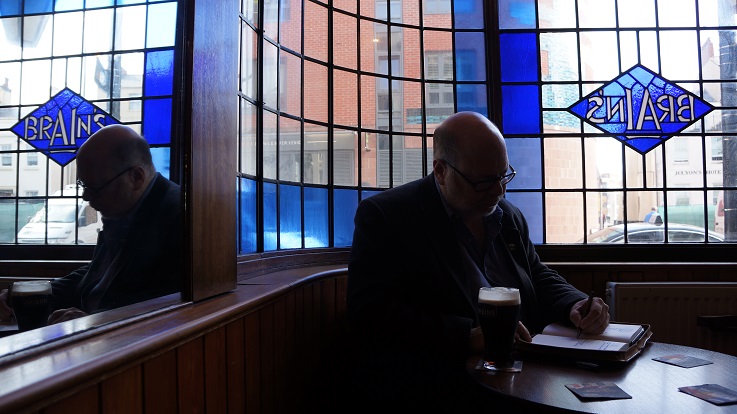 |
56. Politics, Immigration, and Sanctuary, Continued
Part One: A Jew in Cardiff
Before I moved to Cardiff, I was accustomed to confronting Jewish culture frequently, having lived near the cities of the northeast coast of the USA. There were four synagogues within 10 minutes driving of where we lived in Langhorne, Pennsylvania, but here in Cardiff there are no conspicuous signs of Jewish culture. You would be hard pressed to find a greeting card for Rosh Hashanah, Hanukkah, or Passover. It felt a bit odd, but I didn't mind. I was never a good Jew. I am living in Butetown, which is 48% Muslim. Still, I was curious what the Jewish community was like in Cardiff. There is supposed to be a Jewish community, somewhere, but I haven't yet found it.
Although I have no expectations of abandoning my secular beliefs, I have found refuge in many of Cardiff’s beautiful churches. Many is an understatement. I don’t think there is anywhere in this city you can’t spot three churches from where you are standing. Of synagogues there are only two. One of them, I was surprised to learn, is only 8/10th of a mile from my door. As soon as I learned this, I walked over to see what it was like.
The Jews first arrived to England at the invitation of William the Conqueror in 1070 who wanted their business skills. They were not permitted to own land or enter trades - except medicine. They were primarily limited to moneylending with interest. Christians were forbidden to charge interest on loans.
In 1190, over a hundred Jews were massacred in York, England because it was believed they used the blood of Christian children to make Passover matzah. The Jews continued to be unpopular in England in the 13th Century. They were made more unpopular by the ruthless persecution of Henry III, who, while extracting money from them to finance his wars, also passed laws denying them the ability to carry on business. For the first time Jews were obliged to wear badges (1218). His son was no better.
Edward Longshanks (Edward I; he was tall), King of England, conquered Wales in the 13th Century. He expelled the Jews (Edict of Expulsion) from England and Wales in 1290. They were not to be welcomed back until Oliver Cromwell invited them, wanting their financial support. We know of a community of Jews appearing in Swansea in the early 18th Century. It was the 19th Century before we find them mentioned in Cardiff history. By the end of the 19th Century, they were arriving in large numbers.
With the exception of 1911 - the year my father was born in Harlem, New York - the Welsh were tolerant of the Jews. However, in 1911, coalminers in Tredegar rampaged against Jewish-owned businesses, doing considerable damage. Despite this, many more Jews came in the 1930s as refugees of Nazism.
By the 1960s there were over 5,000 Jews living here in Cardiff, yet, by the 2011 census, there were only 840 living in the city. Last year, it was believed to be less than 500; although, I suspect there are many who, like me, are not constantly mindful of being Jews. I no longer embrace my heritage because I do not take pride in its exclusive elitism.
At first I couldn’t find the nearest synagogue, even though I was standing right in front of it. The Cardiff Reform Synagogue was formerly a Methodist Chapel. I didn’t recognize a synagogue in the Victorian Gothic grey stone architecture, with two towers, and with stained glass in the reticulated tracery of the westwork. The Cardiff Reformed Synagogue was founded in 1948 to serve the Jewish immigrants who had found their way to Wales from all over Europe. There were no signs naming the place. The front doors were locked. It appeared that one had to enter the synagogue via the adjacent building, which looked uninvitingly secured, with a button and a perforated steel plate into which to announce your business. I decided not to visit.
Another day, I ventured to the Cardiff United Synagogue, which is 2.8 miles from where I live. This was an Orthodox Jewish synagogue surrounded by nice homes and located at the far end of Cyncoed Gardens. Cyncoed Gardens is an enclosed grassy park with playground where people let loose their dogs and children. This synagogue was a modern redbrick building that looked like an Eisenhower-era elementary school. It was actually built in 2003 and enclosed behind wrought iron fencing. I couldn’t get near it. The Cardiff United Synagogue congregation has been in Cardiff since 1841 and this was merely their newest home.
Yes, I was disappointed that Cardiff’s synagogues are not as accessible as Cardiff’s churches. They do not offer themselves to random visits for meditation and contemplation. There are a disturbing number of possible reasons for this.
I went online to research the two congregations. I had avoided doing so prior because I prefer the physical adventure of discovery. The Cardiff Reform Synagogue summed it up:
| If
you are a member of another UK Synagogue or from
a synagogue abroad. Please send an email at least two weeks in advance to security@CardiffReformSynagogue.uk. We will then send you a visitor’s application form which must be filled out and emailed back BEFORE you attend. We will always do our best to reply to you within 24 hours. Please do not just turn up hoping to be admitted as you will be denied access. |
I have come to Cardiff, Wales to be at home with Ms Keogh, my more significant other. I don’t miss Jewish culture. I did not come to Cardiff, Wales to be at home with “my people”. I have discovered the gentle people who live here to be warm, courteous, egalitarian, talkative, and they sing. I am comfortable with that.
Part Two: At Home with Ms Keogh
Note on the writing of this two-part essay: Ms Keogh usually proofreads the final versions of these essays before I submit them to Snakeskin. This time she was too busy luxuriating in the bathtub reading the book I bought her. I was obliged to sit on the toilet lid and read aloud to her the final draft, forcing her to put aside Bill Bryson’s The Road to Little Dribbling. I got it for half price at Waterstone's.
Three weeks ago, I was in Manhattan. I was there to visit with my friend in the evening, but I came into the city early, content to melt into the rapid flow of pedestrians and let whim and chance dictate an adventure. When it started to rain, I took refuge in the tiny Piccolo Café just north of 37th Street. Sitting at the window counter, watching the traffic and people on Madison Avenue while I was enjoying real coffee and a real bagel with cream cheese, it was in that moment I had my epiphany.
I began a letter to Ms Keogh, my cherished companion and wife of twenty-nine years. From my window on Madison, I could see the new entrance to the Morgan Library and Museum just south of 37th Street. An old favorite, I went to visit the museum, a first time utilizing the senior citizen discount. After viewing the exhibits and seeing again Mr Morgan’s beautiful study and library, I ensconced myself in the library’s new, glass enclosed café and continued the letter to Ms Keogh. The final page I composed later that afternoon in my friend’s apartment:
| Eileen is still at work. No surprise given the career she’s in. She called the concierge and instructed him to give me a spare key to her apartment. I am sitting by the large living room window facing south. [I was sitting on the deep marble sill watching the new World Trade Center emerge from and vanish into a low cloud.] So, I left off telling you I had an astounding realization. This afternoon [at the Piccolo Café], I discovered I like Cardiff more than Manhattan. Can you believe that? Cardiff is just the right size, just the right amount. Oh, if I had to, I would be willing to settle on Manhattan, but Cardiff is more my speed, more my tempo. |
A cost-saving flight carried me from Newark Liberty Airport to Amsterdam Schiphol Airport. From there it was a connecting flight to Cardiff Airport and I was home, sort of. What is home for me? Ms Keogh is my homeland. We now live together in Cardiff.
At the Cardiff Airport, I was held back and interviewed by the border guard after everyone else passed through. Despite the advice I bought from a consultant solicitor and immigration expert, I was informed by the exceedingly pleasant and sympathetic border guard that this would be the last time I should be allowed to enter the UK on a six-month visitor visa. When I leave in November to revisit my mother and vote against Trump, I will not be permitted to return.
That first night after returning from the USA, I couldn’t sleep. I found myself scared of UK Immigration. They are not trying to assist me. Assistance is discouraged by law. It felt obvious that the intent of the laws and practices are to prevent me from gaining “indefinite leave to remain”. My earlier application wasn’t “declined”; it was “rejected”. The error was mine. I filed the wrong application. It was a mistake to attempt to read and understand the UK website for immigration without the expense and assistance of a solicitor.
The temptation is to think of the designers of UK’s immigration law and their website as intentionally wanting to be difficult, as intentionally obfuscating. I must remind myself not to attribute to conspiracy what can be adequately explained by incompetence. I had attempted and failed to fill out the SET(M) application while on USA soil, as my solicitor had instructed. While sojourning in a hotel in Pennsylvania, between visits to my 95-year-old mother, I discovered SET(M) did not apply to me.
I knew I was not being personally targeted by UK immigration, but that didn’t dispel my anxiety. I was still awake when daylight arrived, being worried by the notion that Ms Keogh and I could be separated, or Ms Keogh would have to depart her family and homeland to return with me to the USA. I was also upset about the cost of another solicitor.
UK immigration laws have been revised as of 18th April of this year. I read the FLR(M) application three times and even had Ms Keogh read it to make sure I wasn’t again making the mistake of believing something to be true because I wanted it to be true. She arrived at the same conclusion; the requirements had changed and we were more hopeful of success. Applying for indefinite leave to remain as the spouse of a native born British citizen will require that I prove I am in a real relationship with Ms Keogh and not just some bogus marriage to fool immigration. That will be the easy part. We will seek a new solicitor, someone we can trust and afford. That will be the hard part.
![]()
Mr Bentzman will continue to report here regularly about
the events and concerns of his life. If you've any
comments or suggestions, he would be pleased to hear
from you.
Selected Suburban Soliloquies, the best of Mr Bentzman's earlier series of Snakeskin essays, is available as a book or as an ebook, from Amazon and elsewhere.
